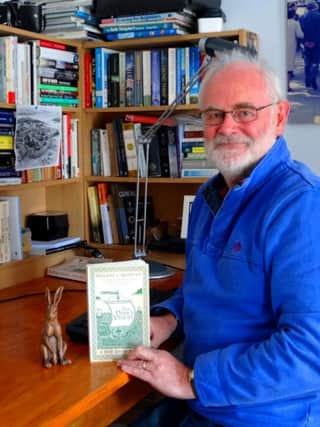Top journey through time, fact and fiction from Jerusalem to Limavady


A new historical novel that starts in ancient Jerusalem and ends in Limavady has recently been published by Co Antrim author William Methven.
Entitled The Hare’s Vision: A new Irish myth, it spotlights the early Irish Christian church and its relationship with the growing power of Rome in the sixth century AD.
Advertisement
Hide AdAdvertisement
Hide AdWith some illustrations by his wife Jenny, the book is Methven’s first and has already been described as an Irish Lord of the Rings.
It is a bewitching story about an Irish monk, Cormac, his muse Zachariah the hare and their strange band of companions.
They travel from ancient Egypt to Ireland to protect ‘The Word’, a sacred scroll dating from the time of Jesus, from those who want to suppress its inspiring and radical message.
In modern times ‘The Word’ is re-discovered buried under the ruins of an ancient church in Dunseverick on the north coast of Northern Ireland.
Advertisement
Hide AdAdvertisement
Hide AdHow did the sacred scroll get there and what are the implications for the modern world of its radical message?
Methven’s narrative takes the reader back to the sixth century when ‘The Word’ came to light during a search of the Great Library of Alexandria in Egypt. But its contents are seen as too controversial by the Patriarch of Alexandria who sends an Irish monk living in a remote Egyptian desert monastery back to Ireland with The Word.
The monk’s task is to deliver it to the great Abbot Colum Cille (St Columba) for safe keeping, well away from Rome.
The drama begins when the Bishop of Rome becomes aware of the scroll and dispatches an emissary to Ireland to seize it for the Holy See.
Advertisement
Hide AdAdvertisement
Hide AdWhat follows is a dramatic odyssey from Alexandria by sea to the Shannon estuary and from there through Ireland to a thrilling finale at an assembly in Druim Ceit near Limavady.
During the monk’s journey through Ireland, pursued by the Roman emissary, the reader is given an insight into the nature of Ireland’s Celtic Christianity at the time.
Methven believes that this form of Christianity was very different to the later Roman version that didn’t arrive in Ireland until the Norman invasion at the end of the twelfth century.
“The book is the culmination of two years historical research,” explained Methven who reckons “there is not much that’s popularly understood about this pivotal period in Irish history.”
Advertisement
Hide AdAdvertisement
Hide AdSo he utilises a storytelling style instead of writing a traditional history book.
“After all, storytelling is the Irish way,” he said, adding “So although it is fiction, it is as historically accurate as possible in order to give it credibility. However, you can’t tell a story about ancient Ireland without mixing historical fact with myth and legend!”
According to the author “there is much to be understood about the early Irish Church that could help us to recognise our common heritage on both sides of the political and religious divide on this island. If we have Irish or Ulster Scots heritage then the people of sixth century Ireland are our ancestors. I believe understanding their religious beliefs and secular customs from this time can help us realise that we have much more in common than that which divides.”
The story covers a lot of ground in every sense, starting in Jerusalem, then moving to Egypt and ending in Limavady.
Advertisement
Hide AdAdvertisement
Hide AdThe race towards Colum Cille on the north coast brings the monk and his companions along the Shannon and Erne waterways by curragh after landing at Scattery island in the Shannon Estuary.
They travel on to Clonmacnoise monastery in County Offaly, the sacred Hill of Uisneach in Westmeath, followed by Devenish Island in Lough Erne, Beaghmore stone circles near Cookstown, Camus Monastery near Coleraine and finally to Druim Ceit at Limavady.
There is also a stop-off in the underworld of the mythical De Danaan.
For his part, the Roman emissary finds himself entertained by the High King of Ireland, Aed mac Ainmuirech of the Donegal O’Neills, at the Hill of Tara in Co. Meath where he encounters the beautiful Queen Ronnat.
Advertisement
Hide AdAdvertisement
Hide AdEven the British get in on the act with a military leader called Artur (ring any bells!) planning to sneak the sacred scroll to Britain.
The thought-provoking and highly entertaining story ends in the Londonderry of today with a group of civil servants and clergy grappling with the re-discovery of the ancient scroll at Dunseverick and wondering how to manage the impact of The Word’s radical message on both political and religious life in the 21st century.
At the end of the story the reader is left wondering if it’s true, so effectively has fact been woven with fiction!
“The book aims to set dramatic events in places in Ireland that many people will know,” says Methven, “but also locations that many won’t know, particularly foreign tourists wishing to understand more about the relationship between our landscape and our history. For this reason I’m planning to replicate the voyage taken in the book later this year, mostly by curragh from Scattery Island in the Shannon estuary all the way to Devenish in Lough Erne and then on by foot to Druim Ceit near Limavady.”
Advertisement
Hide AdAdvertisement
Hide AdWilliam is inviting fellow-travellers and the media to join him on his epic journey.
His book is currently available in both paperback and kindle formats on Amazon. To get in contact with William Methven e-mail [email protected]